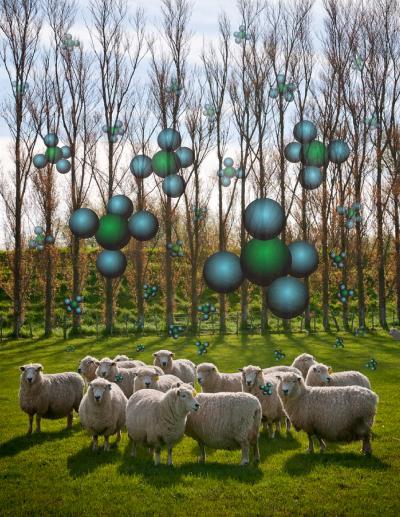With the successful leveling off of CO2, a long-lasting greenhouse gas implicated for most global warming, due to a switch to natural gas, activists have been focusing on methane.
While some of the claims have been controversial and used decades old Soviet data to exaggerate the issue, we do know that about 20 percent of methane emissions are due to livestock. Most people and a better standard of living means more need for food. Ruminants, like sheep and cows, burp methane.
It's not the crisis vegetarian groups make it out to be. In New Zealand, where sheep outnumber people 7 to 1, there has been no drastic increase in methane. It is 23X the warming effect of CO2, though scientists who noted that during the 1990s were replaced on the Intergovernmental Panel on Climate Change (IPCC). Nitrous oxide emissions have also received renewed attention now that Germany is on target to meet its 2020 CO2 goal and the US is back to early 1990s also.
Maybe science can genetically modify ruminants to produce less methane, that will annoy a completely different segment of the anti-science movement, but until then researchers at NZ's AgResearch Limited
and the U.S. Department of Energy Joint Genome Institute deployed high throughput DNA sequencing and specialized analysis techniques to find out why some animals emit more methane than others.

Sheep; a decade ago you got no respect in global warming, but now that CO2 emissions have dropped, it is your turn. Sheep image courtesy of AgResearch/Gerry le Roux, Sciencelens. Art by Wayne Keefe, Berkeley Lab Creative Services.
They wanted to find out the role of "microbiomes" (the microbes living in the rumen) play in this process. Microbiomes are all the latest rage, it's epigenetics of 2014 - the new Prius. Exercise? It changes your microbiome. Expensive yogurt? Microbiome.
To learn why the amount of methane that ruminants produce varies, the researchers took advantage of a large sheep screening and breeding program in NZ that aims to breed low methane-emitting ruminants without impacting other traits such as reproduction and wool and meat quality. The team measured the methane yields from a cohort of 22 sheep, and from this group, they selected four sheep with the lowest methane emissions, four sheep with the highest emissions and two sheep with intermediate emission levels.
Rumen metagenome DNA samples collected on two occasions from the 10 sheep were sequenced at the DOE JGI, generating 50 billion bases of data each.
"The deep sequencing study contributes to this breeding program by defining the microbial contribution to the methane trait, which can be used in addition to methane measurements to assist in animal selection," said senior scientist Graeme Attwood of AgResearch Limited, a senior author on the paper.
The team then checked to see if there was a correlation between the proportions of methanogens in the eight sheep with the highest and lowest recorded methane emissions. In sheep with low methane emissions, they found elevated levels of one particular species of methanogen (Methanosphaera) while sheep with high methane emissions had elevated levels of another group of methanogens (Methanobrevibacter gottschalkii).
Exploring further, the team then identified a methane-producing pathway and three variants of a gene encoding an important methane-forming reaction that were involved in elevated methane yields. While the overall changes to the methane-producing microbial community structure and methanogen abundance across sheep were rather subtle, the team reported that the expression levels of genes involved in methane production varied more substantially across sheep, suggesting differential gene regulation, perhaps controlled by hydrogen concentration in the rumen or by variations in the dwell time of their feed.
"It's not so much the actual composition of the microbiome that determines emission—which conventional wisdom would suggest—but mostly transcriptional regulation within the existing microbes that makes the difference, which is a concept that is relatively new in metagenomic studies," said DOE JGI Director Eddy Rubin. The team's findings suggest new possible targets for mitigating methane emissions at the microbiome level.
Screening and breeding for low-methane producing sheep is still underway, and importantly, low-methane lines then need to be tested for stability of the trait, as well as the absence of any impacts on fertility or meat or wool production. Moreover, as Attwood notes, "there needs to be an incentive for farmers to incorporate low methane animals into their flocks, that is, achieving better performance with the low methane animals or being able to claim carbon credits. If everything went well you could expect introduction of the low methane trait to begin in three years, and for there to be slow but incremental changes to the sheep industry in subsequent years."
The DOE Office of Science supported the sheep rumen research at the DOE JGI. The NZ Fund for Global Partnerships in Livestock Emissions Research funded the work done in NZ to support the objectives of the Livestock Research Group of the Global Research Alliance on Agricultural Greenhouse Gases, and the NZ Agricultural Greenhouse Gas Research Centre and the NZ Pastoral Greenhouse Gas Research Consortium made the methane screening data and animal resources available. The data from the study complement the genomic sequences being generated from the Hungate1000 project which seeks to produce a reference set of rumen microbial genomes from cultivated rumen bacteria and archaea, together with representative cultures of rumen anaerobic fungi and ciliate protozoa.
Source: DOE/Joint Genome Institute





Comments